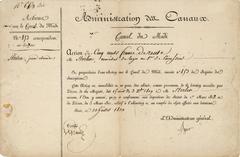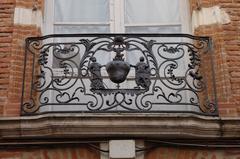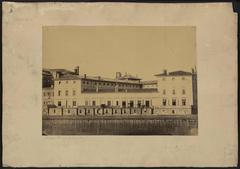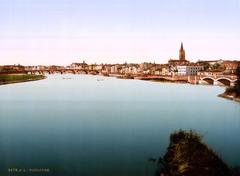
Battle of Toulouse Obelisk: Visiting Hours, Tickets, and Historical Significance in Toulouse, France
Date: 03/07/2025
Introduction
The Battle of Toulouse Obelisk stands as a powerful testament to the city’s layered and resilient history. Situated in the vibrant heart of Toulouse, France, this monument commemorates two significant clashes: the 1814 Napoleonic battle and the 721 defense led by Duke Odo of Aquitaine. As both a site of remembrance and an architectural landmark, the obelisk offers locals and travelers a unique portal into the military, cultural, and civic legacy of the “Ville Rose.” This comprehensive guide provides essential information on the monument’s history, visiting details, accessibility, and nearby attractions, empowering you to make the most of your visit.
Table of Contents
- Historical Background
- The Battle of Toulouse Obelisk
- Visiting Information
- Nearby Attractions and Suggested Itineraries
- Events and Commemorations
- FAQ
- Conclusion
- References and Further Reading
Historical Background
The 1814 Napoleonic Battle
The Battle of Toulouse, fought on April 10, 1814, was one of the final conflicts of the Napoleonic Wars. Allied forces, led by the Duke of Wellington, comprised British, Portuguese, and Spanish troops who advanced into southern France, pressing Marshal Soult’s French forces to a defensive position within the city (Britannica; Napoleonguide). Soult’s army, though depleted, strategically utilized Toulouse’s natural and man-made defenses, including the Languedoc Canal and nearby high ground (Information Britain).
Despite the Allies’ eventual capture of Toulouse and over 8,000 combined casualties, the French army retreated intact. The battle’s tragic irony lies in its timing: it was fought days after Napoleon’s abdication, news of which had not reached the commanders (Britannica). The engagement symbolizes both the resilience and losses of the era, and it remains a point of historical debate as to its significance (Wikipedia; Napoleonguide).
The 721 Medieval Battle
Centuries earlier, the city withstood another pivotal siege in 721 CE. Duke Odo the Great of Aquitaine, after gathering reinforcements, successfully defended Toulouse against the Umayyad army under Al-Samh ibn Malik al-Khawlani (Wikipedia). Odo’s unexpected counterattack broke the siege, checking Umayyad expansion into Western Europe and establishing the city as a bastion of resistance (DayHist; History Snacks).
The 721 victory, celebrated throughout Christendom, set the stage for future resistance to external threats, culminating in the more famous Battle of Tours in 732.
The Battle of Toulouse Obelisk
Origins and Architectural Features
The Battle of Toulouse Obelisk was erected in the 19th century as a commemorative monument, typical of a period in France marked by renewed interest in national history and identity. Built from local stone in the classical obelisk tradition, its soaring, four-sided shaft and pyramidion are symbolic of endurance and remembrance (Wikipedia).
Inscriptions on the obelisk honor the “brave men who died for the fatherland” from both sides of the 1814 engagement (military-history.fandom). Some variants or older monuments in Toulouse also reference the 721 battle and Odo’s role.
Symbolism and Civic Role
Beyond its form, the obelisk serves as a locus for civic pride and memory. It is a place for annual commemorations, educational activities, and reflection on Toulouse’s enduring role in European history (DayHist). Its prominent siting integrates it into the city’s daily life and urban landscape, complementing Toulouse’s renowned pink-brick architecture (Kirstie Will Travel).
Visiting Information
Location and Accessibility
The Battle of Toulouse Obelisk is centrally located near Rue Saint-Bertrand, within easy walking distance of Place du Capitole and Basilique Saint-Sernin (Cocon A 5Minutes Du Capitole Apartment). The area is well-served by public transportation, including the Marengo-SNCF metro station—a 6-minute walk away (Le T2 De Melodie Marengo Sncf).
- On Foot: The city center is compact and pedestrian-friendly.
- By Bicycle: Toulouse offers dedicated cycling paths and rental services (Guide Toulouse Pyrenees).
- By Car: Parking garages are available nearby, but walking or public transport is recommended.
The site is generally flat and paved, making it accessible for visitors with limited mobility. Some nearby streets may have cobblestones.
Visiting Hours and Tickets
- Hours: Open-air, accessible 24/7, all year round.
- Tickets: Entry is free; no reservation required (Voyage Tips).
Practical Tips
- Best Time to Visit: Spring (April–June) and early fall (September–October) offer comfortable weather and fewer crowds (Over Your Place; Travel Setu).
- Facilities: No public restrooms at the monument, but cafés and restaurants are nearby.
- Accessibility: Benches are available; area is suitable for wheelchairs except for some uneven cobblestones.
- Safety and Etiquette: Toulouse is safe, but standard precautions apply. Respect the monument’s solemn purpose—avoid climbing or leaving litter.
Nearby Attractions and Suggested Itineraries
The obelisk’s central location makes it ideal to include in a historical walking tour. Notable nearby sites include:
- Place du Capitole: The city’s iconic square with impressive architecture (Voyage Tips).
- Basilique Saint-Sernin: A UNESCO-listed Romanesque church.
- Musée des Augustins: Art museum in a former monastery.
- Couvent des Jacobins: Renowned for its Gothic “palm tree” column (Passaporte No Bolso).
- Garonne River Quays: Scenic walks along the river.
For dining, the Victor Hugo Market and surrounding bistros offer local specialties like cassoulet and Toulouse sausage.
Events and Commemorations
While the obelisk itself does not host regular events, it is a focal point for commemorative ceremonies on battle anniversaries and national holidays, such as Bastille Day. During these times, visitors may witness wreath-laying or historical reenactments—check the Toulouse Tourism Office calendar for event information.
FAQ
Q: Are there entrance fees?
A: No, visiting the obelisk is free.
Q: What are the visiting hours?
A: The monument is accessible 24/7, year-round.
Q: Is the site wheelchair accessible?
A: Yes, the area is generally flat and paved, though some nearby cobblestones may pose minor challenges.
Q: Are guided tours available?
A: Several walking tours of the historic center include the obelisk (Voyage Tips).
Q: Is photography allowed?
A: Yes, photography is encouraged—early morning or late afternoon offers the best light.
Conclusion
The Battle of Toulouse Obelisk is much more than a historic marker—it is an anchor for Toulouse’s collective memory. Freely accessible and centrally located, the monument invites visitors to contemplate the city’s legacy of resilience, sacrifice, and renewal. Combine your visit with nearby attractions for a deeper understanding of Toulouse’s unique heritage, and consider joining a guided tour for enhanced context.
For the latest information, maps, and audio guides, consult the Toulouse Tourism Office or download the Audiala App. Let the obelisk be both your starting point and your inspiration as you explore the rich tapestry of Toulouse.
References and Further Reading
- Battle of Toulouse (1814), Encyclopædia Britannica (Britannica)
- Battle of Toulouse (1814), Napoleonguide.com (Napoleonguide)
- Battle of Toulouse (721), Wikipedia (Wikipedia)
- Battle of Toulouse: Odo of Aquitaine Victory, DayHist (DayHist)
- Complete Toulouse Travel Guide, Kirstie Will Travel (Kirstie Will Travel)
- Discover the Battle of Toulouse Obelisk, Voyage Tips (Voyage Tips)
- Cocon A 5Minutes Du Capitole Apartment, Hotel Est Toulouse (Cocon A 5Minutes Du Capitole Apartment)
- Official Toulouse Tourism Office (Toulouse Tourism Office)
- Audiala App for Guided Tours (Audiala App)



























